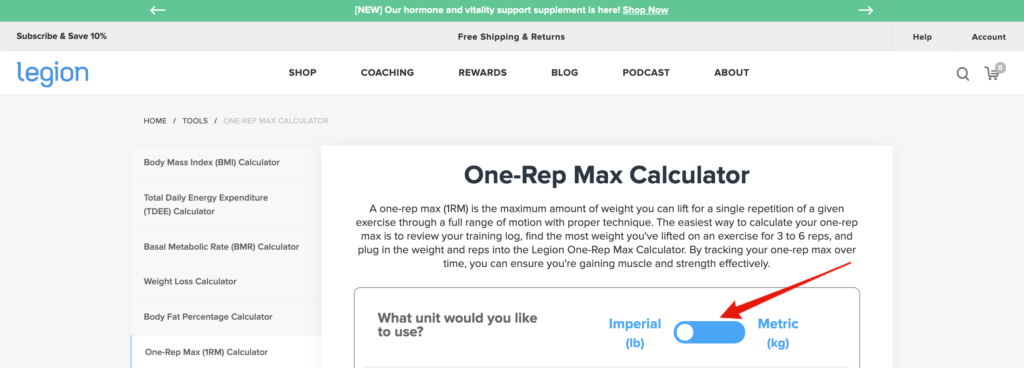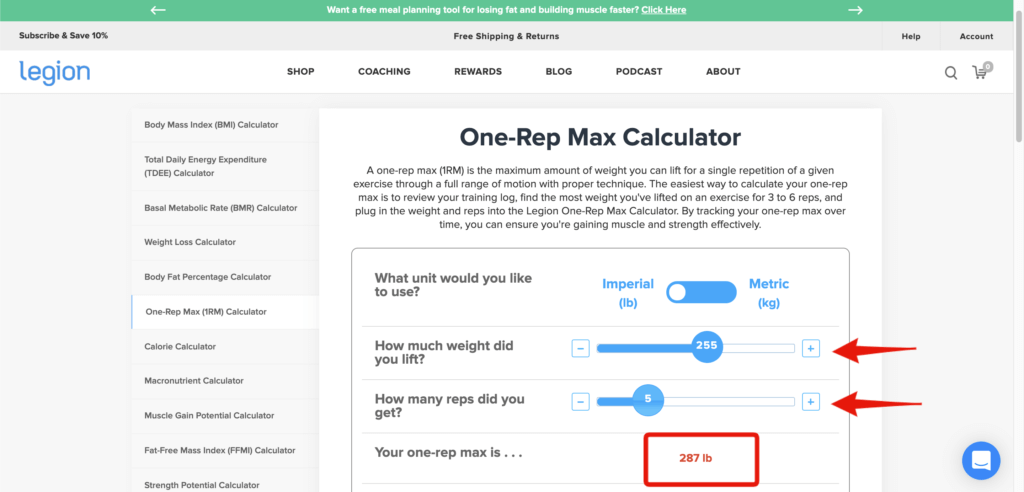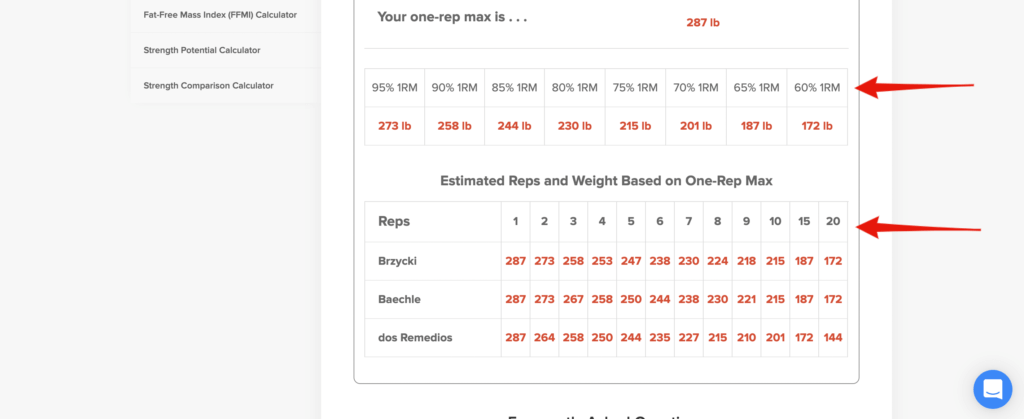A one-rep max is the maximum amount of weight you can lift for a single repetition of a given exercise through a full range of motion with proper technique.
In other words, it’s how much weight you can push, pull, or squat for a single rep.
And why is this important, pray tell?
The first thing you need to know about calculating your one-rep max is that it’s good for more than bragging rights.
Sure, it’s fun to know how you stack up against other guys and gals in the gym, but there’s a better reason to care:
Knowing your one-rep max helps you maintain optimal workout intensity (and thereby achieve optimal results).
It allows you to train hard enough to get the maximum muscle-building stimulus out of every workout, without training so hard that you increase the risk of injury or run into symptoms related to overtraining.
And in this article, you’re going to learn the best way to calculate your one-rep max for every exercise.
Table of Contents
+
What Is A One-Rep Max (1RM)?

As you just learned, a one-rep max is the maximum amount of weight you can lift for a single repetition of a given exercise through a full range of motion with proper technique.
In fitness circles, it’s usually referred to as your 1RM.
Let’s unpack that a bit. More specifically, a 1RM is . . .
- The maximum amount of weight you can lift for one repetition . . . assuming you’re warmed up, rested, and just starting your workout (without doing any other sets or exercises beforehand). Basically, how much you can lift under ideal conditions.
- Specific to each exercise. Your one-rep max for your front squat could be very different from your one-rep max for your back squat, even though they involve similar muscle groups, so you need to calculate it separately for each exercise.
- Requires full range of motion. (Quarter reps don’t count.)
- Requires proper technique. If you’re rounding your back while deadlifting, letting your knees cave in while squatting, or letting your butt hop off the pad while bench pressing, you’re ginning up your numbers at the expense of your health.
Pretty straightforward.
Why You Should Know Your One-Rep Max
The most reliable way to gain muscle is to get stronger.
As your one-rep max is simply the maximum amount of weight you can lift for a single repetition for a particular exercise, it’s an excellent way to determine whether or not you’re getting stronger. In other words, your one-rep max is a rough proxy for muscle growth and directly correlated with your strength.
The relationship between muscle gain and strength isn’t perfect and doesn’t work well for comparing progress between two different people, though. For example, just because one person has a higher bench press one-rep max than another doesn’t mean they’ll necessarily have a bigger chest, as other factors also influence muscle growth.
What you can count on, though, is that if your one-rep max is going up for a particular exercise, the muscles that are trained by that exercise are growing. If your old bench press 1RM was 155 pounds and your new one is 225—you can bet the farm that your chest, triceps, and shoulders are bigger, too.
Another benefit of knowing your 1RM is that it helps you program your workouts more effectively.
You see, if your goal is to gain muscle, the sweet spot for training intensity is about 1 to 3 reps shy of failure (the point at which you can’t complete another rep with good form). You don’t want to go to failure on most of your sets, as this interferes with your recovery and long-term progress. You also don’t want to train too far away from failure (say, 4+ reps from failure), as this kind of training isn’t as effective for building muscle.
Thus, you want most of your sets to be in this Goldilocks zone between 1 and 3 reps shy of failure.
One of the best ways to do this is to set your training weights according to a percentage of your 1RM.
For instance, most weightlifters can do about 6 reps with 85% of their 1RM before they reach failure. If you want to stay in the sweet spot I just described—1 to 3 reps shy of failure—you could subtract two reps from 6 (6 – 2 = 4) and shoot for this number of reps with 85% of your 1RM. This way, you know you’ll be about 2 reps shy of failure at the end of your set.
Why You Shouldn’t Test Your One-Rep Max Too Often
The only 100%-accurate way to know how much weight you can lift for a single rep is to actually do it, but that comes at a cost.
A true one-rep max attempt is time-consuming, risky, and exhausting for several reasons:
- To test your true max, you first need to train with lighter weights and lower volumes for several days to a week beforehand to make sure you’re rested. (This is referred to as deloading).
- You then have to push yourself very close to failure, which is where your technique is most likely to break down and precipitate an injury.
- Finally, a true one-rep max test is going to leave you feeling drained for at least a few days, during which you’ll need to use lighter weights or lower volumes.
All in all, preparing for and recovering from a true, balls-to-the-wall one-rep max test entails a significant interruption in your normal training routine. Thus, it’s not only unnecessary but also unwise to test your one-rep max too often.
This is why many serious weightlifters and powerlifters only test their one-rep max a few times per year, and sometimes just once per year.
And if your main goal is to build muscle, you don’t need to ever do a true 1RM test. Instead, you can use what’s called a rep-max test instead . . .
The Best Way to Estimate Your One-Rep Max

Instead of doing a true one-rep max test, most savvy weightlifters use equations to predict their one-rep max based on how many reps they can get with a lighter weight.
This is referred to as rep-max testing, because you’re figuring out the maximum amount of weight you can lift for multiple reps (not just one) with a given weight. Sometimes, a rep-max test is also referred to as an AMRAP test, which stands for As Many Reps As Possible.
I recommend you use a weight that allows you to get 2 to 6 reps in your rep-max tests, as this rep range strikes the best balance between accuracy and difficulty. Lower rep sets (~2 to 6) are more accurate in predicting your one-rep max than higher-rep sets (6+), but still not as draining as a true one-rep max.
After performing a rep-max test, you use an equation to predict your one-rep max based on how many reps you got with the weight. Or, you can plug your numbers into a one-rep max calculator that does all of the math for you, like the Legion One-Rep Max Calculator.
How to Test Your One-Rep Max in 8 Steps
Follow this simple eight-step process to do a rep-max test and estimate your one-rep max:
- Decide what exercise you’d like to estimate your one-rep max for, and move it to the beginning of your workout. For example, if you normally incline bench press before flat bench press, and you want to test your flat bench press one-rep max, switch around your exercise order so you flat bench press first.
- Do a thorough warm-up.
- Once you’re finished with your warm-up, rest at least 3 to 4 minutes.
- Load the bar (or pick up dumbbells) with a weight that you think you can lift for 2 to 6 repetitions.
- Set up, brace properly, and do as many reps as you can before your technique starts to falter or your reach muscular failure.
- If you got 2 to 6 reps, write down how much weight you used and how many reps you got. This is your “rep max.”
- If you got 7 or more reps, add 5 to 10 pounds to the barbell or dumbbells, rest at least 3 to 5 minutes, and try again. You might be a little tired, but you should still have enough gas left in the tank to beat your numbers from the first set.
- After completing your rep-max test, finish your regular workout.
Then, with new rep-max results in hand, plug your numbers into the Legion One-Rep Max Calculator to estimate your one-rep max!
How to Use the Legion One-Rep Max Calculator
First, perform a rep-max test following the guidelines in this article.
Then, open up the Legion One-Rep Max Calculator, and enter what unit you’d like to use (pounds or kilograms):

Then, enter how much weight you lifted and for how many reps (use the slider to get close to your desired number, then dial it in using the plus or minus buttons). Let’s say I bench pressed 255 pounds for 5 reps:

According to the calculator, my estimated one-rep max is 287 pounds.
In other words, if I did an actual one-rep max test, I’d probably get close to 287 pounds.
If you scroll down, you’ll find that the Legion One-Rep Max Calculator also tells you how different percentages of your one-rep max translate into training weights, and how many reps you’d probably get with these weights before reaching failure:

This is particularly helpful if you’re following a periodized strength training program like the Beyond Bigger Leaner Stronger Program.
FAQ #1: Do you really need to do a rep-max test?
You don’t need to, but you should.
One way to estimate your one-rep max is to look at your workout log from the past few weeks and find the most weight you lifted for an exercise and for how many reps. Then, you can plug those numbers into the Legion One-Rep Max Calculator. Basically, you treat one of your recent best workouts as a rep-max test.
This is how I typically estimate my one-rep max, because it’s convenient, fast, and doesn’t require changing my workout routine. It also allows me to quickly see how my one-rep max is progressing from week-to-week and month-to-month.
There are a few problems with this method that can make you underestimate your true one-rep max, though, including:
- Doing one exercise after another in your workouts (flat bench after incline, for example), which makes you weaker on the second exercise.
- Training consistently for several weeks without deloading, which means your true strength is at least slightly impaired by residual fatigue.
- Training several reps shy of failure on your working sets, which means you haven’t truly pushed yourself to your limits.
Thus, while this kind of on-the-fly rep-max testing gives you a good sense where your lifts stand, it’s not a replacement for a real rep-max test for gauging long-term progress.
FAQ #2: How often should you test your one-rep max?
A good frequency for rep-max testing is every 2 to 4 months. That’s often enough to provide accurate numbers for programming your workouts, but infrequent enough to not get in the way of your normal workout routine.
A simple way to schedule your rep-max tests is to put them on the first day back after a week-long deload or after a vacation. This ensures you’re recovered, rested, and ready to put your shoulder to the wheel.
If you want to do a true one-rep max test and not just a rep-max test, I recommend you don’t do this more than once or twice per year for each exercise.
FAQ #3: How should you schedule a one-rep max test into your weekly workout routine?
First, remember that you want to do your rep-max testing the week after a deload or vacation to ensure you’re fresh.
Second, it’s best to do no more than one rep-max test for a particular exercise per day for the reasons explained above. If you’re doing rep-max tests for the same muscle group multiple times in the same week (bench and overhead press, for instance), try to include one to two rest days between each rep-max test.
For example, here’s how your deload week and rep-max week might look like if you’re following a push pull legs split:

FAQ #4: Should you test your one-rep max for isolation exercises like biceps curls?
You don’t need to.
Estimating your one-rep max for your squat, bench press, deadlift, and overhead press is sufficient for ensuring that you’re getting stronger and building muscle over time. If you want to do rep-max tests for other exercises, here are some suggestions:
- Romanian deadlift
- Trap-bar deadlift
- Sumo deadlift
- Front squat
- Pull-up or chin-up
FAQ #5: How do you mentally prepare yourself for a one-rep max test?
There are many things you can do to get yourself in the right frame of mind for a one-rep or rep-max test, but here are some of my favorites:
- Do a thorough warm-up.
- Get at least 8 to 10 hours of sleep for a few nights leading up to your test. At the very least, let yourself get up without an alarm the morning of the test to ensure you’re rested.
- Eat a meal with 20 to 50 grams of protein and carbs 1 to 2 hours pre-workout.
- Listen to your favorite music on the way to the gym, during your warm-up, and in the minutes right before your test (I like to save my favorite songs for right before and during the test itself).
- Use active imagery to visualize yourself successfully completing your one-rep max test.
- Recruit a spotter. Not only can they save your bacon if you hit failure, but knowing someone has your back and is rooting for you makes you work harder.
- Have a goal in mind. Tinker around with the Legion One-Rep Max Calculator to figure out how many reps you’d need to get with a particular weight to set a new PR, and go for it.
- Drink a caffeinated pre-workout supplement 30 to 60 minutes before your test (this works even better if you re-sensitize your body to the effects of caffeine for one to two weeks before your test).
That last point is worth punching up.
The fact is that no matter how well you prepare for a one-rep max test, life often throws a monkey wrench into your plans: late-night meetings that cut into your sleep, stressful decisions that disrupt your concentration, and other obligations and vagaries that scatter your workout schedule and sap your motivation.
In times like these, a pre-workout supplement can be one of the best ways to break through these barriers and conquer a one-rep max test.
And if you’re looking for a 100% natural pre-workout supplement, try Pulse. It increases energy levels, improves mood, sharpens mental focus, boosts strength and endurance, and reduces fatigue—just what you need when you’re readying yourself to set a new 1RM.
And if you prefer to get your caffeine from coffee—try stacking it with caffeine-free Pulse!
What’s your take on one-rep max calculation? Have anything else to share? Let me know in the comments below!
Scientific References +
- Simão, R., Farinatti, P. D. T. V., Polito, M. D., Viveiros, L., & Fleck, S. J. (2007). Influence of exercise order on the number of repetitions performed and perceived exertion during resistance exercise in women. Journal of Strength and Conditioning Research, 21(1), 23–28. https://doi.org/10.1519/00124278-200702000-00005
- Mayhew, J. L., Johnson, B. D., Lamonte, M. J., Lauber, D., & Kemmler, W. (2008). Accuracy of prediction equations for determining one repetition maximum bench press in women before and after resistance training. Journal of Strength and Conditioning Research, 22(5), 1570–1577. https://doi.org/10.1519/JSC.0b013e31817b02ad
- Reynolds, J. M., Gordon, T. J., & Robergs, R. A. (2006). Prediction of one repetition maximum strength from multiple repetition maximum testing and anthropometry. Journal of Strength and Conditioning Research, 20(3), 584–592. https://doi.org/10.1519/R-15304.1
- Paula Dohoney, Joseph A Chromiak, Derek Lemire, & Ben R Abadie. (n.d.). (PDF) Prediction of one repetition maximum (1-RM) strength from a 4-6 RM and a 7-10 RM submaximal strength test in healthy young adult males. Retrieved February 22, 2021, from https://www.researchgate.net/publication/228503989_Prediction_of_one_repetition_maximum_1-RM_strength_from_a_4-6_RM_and_a_7-10_RM_submaximal_strength_test_in_healthy_young_adult_males
- E R Helms, P J Fitschen, A A Aragon, J Cronin, & B J Schoenfeld. (2009). Recommendations for natural bodybuilding contest preparation: resistance and cardiovascular training. In Medicine and Science in Sports and Exercise (Vol. 41, Issue 3, pp. 687–708). https://doi.org/10.1249/MSS.0b013e3181915670










